Learn how to make chocolate at home using these chocolate-making tips.
Once you learn the basics, you'll be able to make delicious homemade chocolates that look amazing too.
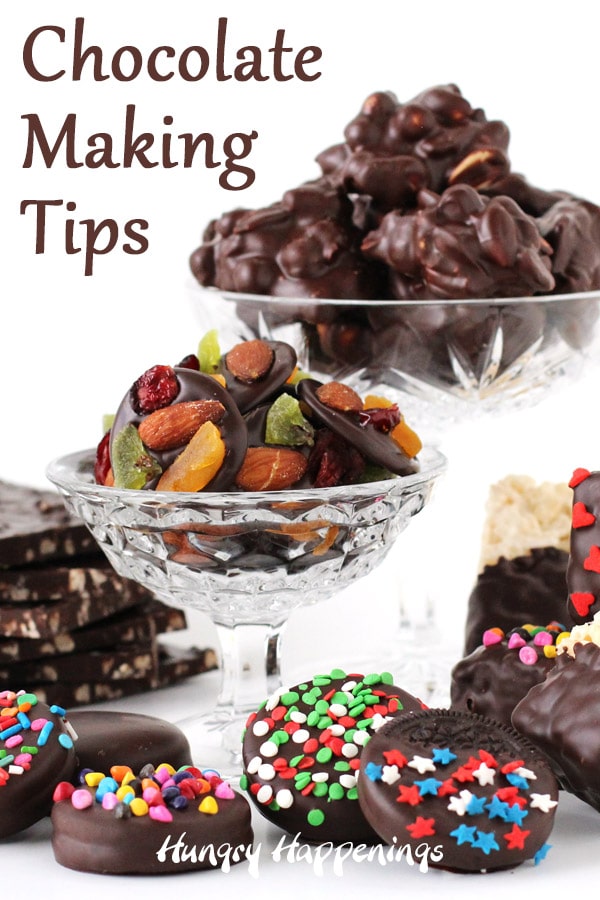
Thanks for stopping by to learn how to make homemade chocolates. I have been a chocolatier for over 30 years and am so excited to share these chocolate-making tips with you. I have been blogging since 2010 and have shared hundreds of chocolate recipes here on this blog.
Once you learn the basics, you can create amazing chocolate candies and desserts to share with family and friends.
If you prefer to learn visually, check out my Chocolate Making Course video series from The Sugar Academy.
In this tutorial you will learn:
- the difference between pure chocolate and compound chocolate
- how to melt and temper pure chocolate
- how to melt compound chocolate (also known as confectionery coating, candy melts,
almond bark, or melting wafers)
- how to melt compound chocolate (also known as confectionery coating, candy melts,
See these other tutorials for more information:
- how to color white chocolate and white confectionery coating
- how to paint candy molds using colored chocolate
- how to make and use modeling chocolate (candy clay)
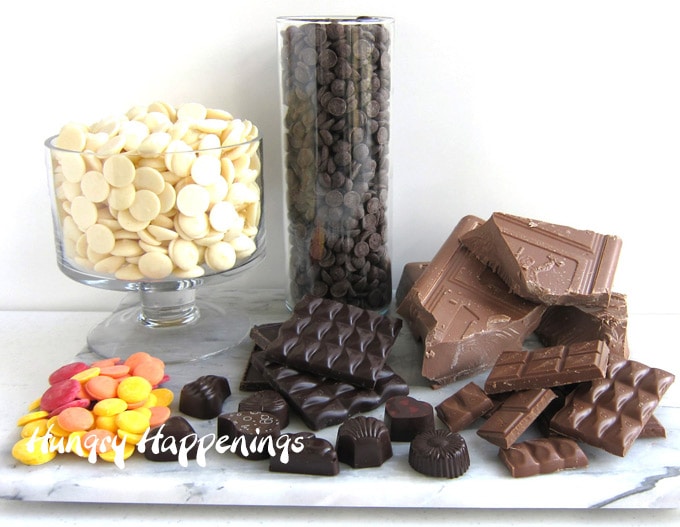
Let's start with the basics.
TYPES OF CHOCOLATE
There are several different types of chocolate that are available to the home cook for use in candy making:
Pure chocolate (real chocolate)
- contain cocoa butter
- has a luxuriously creamy texture and rich flavor
- must be properly tempered in order to set up correctly
- can be purchased in bars, blocks, wafers, pistoles (bean-shaped wafers), callets (slightly smaller wafers), and chips
- is available as:
- unsweetened (no sugar added)
- bittersweet (small amount of sugar added)
- semi-sweet (more sugar added)
- milk chocolate (milk powder and sugar added)
- white chocolate which can also contain cocoa butter but it doesn't contain any cocoa liquor, so technically it is not considered chocolate (But that is what it is called, so that's what we'll call it too!)
You can use pure chocolate to make:
- Hot Chocolate Bombs
- Artisan Chocolates decorated with Chocolate Transfer Sheets
- Chocolate Truffles
- Chocolate Cups filled with Chocolate Mousse
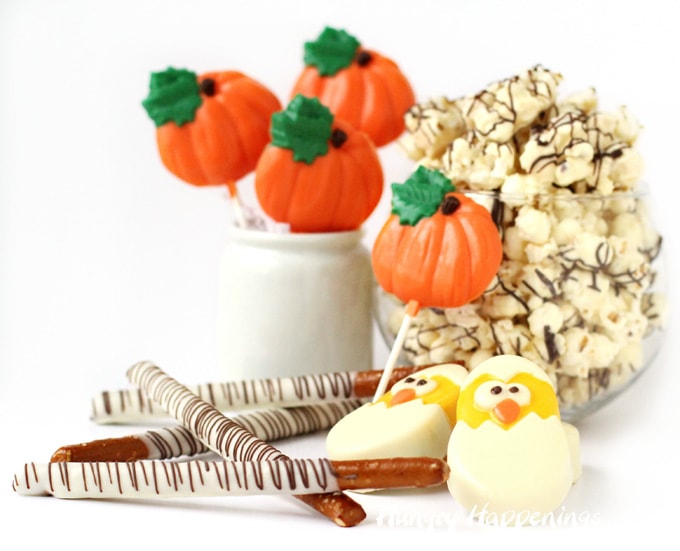
Compound Chocolate (also known as confectionery coating, Candy Melts, almond bark, or melting wafers)
- contain vegetable oil, typically palm kernel oil
- will melt and set up easily with little effort
- is not as creamy or as rich as pure chocolate, but it’s easy to use and has a very pleasant flavor
- is available in dark, light, white, and flavors like peanut butter, mint, and butterscotch
- can be colored using candy coloring but is also available in colored wafers
- is typically less expensive than pure chocolate
NOTE about compound chocolate and wax
- The melting point of compound chocolate is higher than that of pure chocolate which means that it will take longer to melt on your tongue which can give it a waxy feel in your mouth.
- However, there is no wax in compound chocolate, candy melts, or almond bark, as some people believe. What you are feeling on your tongue is palm kernel oil, not wax.
- Being cocoa butter melts at a lower temperature and melts quickly as soon as it hits your tongue, you will not feel this waxy sensation when eating pure chocolate.
You can use compound chocolate to make:
- White Chocolate Popcorn and a White Chocolate Popcorn Bowl
- Hand-painted Easter chocolates and lollipops
- Pretzel Pops
- Sprinkle Coated Chocolate Cups filled with ice cream or candy
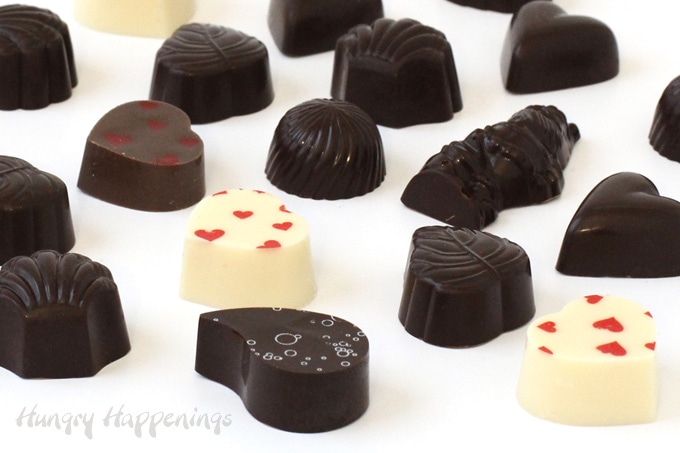
Buying chocolate for candy making.
I personally use Peters Burgundy (semi-sweet), Peter's Ultra (milk chocolate), and Callebaut dark, milk, and white chocolate callets for my chocolate making, but there are many other delicious brands of chocolate.
Choose the chocolate you like to eat. Everyone enjoys different flavors so you need to find your favorite.
my favorite pure chocolate brands
Some brands of chocolate I recommend using are available on Amazon.com.
I earn a small commission when you use the links below at NO extra cost to you.
 Peter's Gourmet Burgundy Di...Shop on Amazon
Peter's Gourmet Burgundy Di...Shop on Amazon  Callebaut No 811 Finest Bel...Shop on Amazon
Callebaut No 811 Finest Bel...Shop on Amazon  Belgian Milk Chocolate Baki...Shop on Amazon
Belgian Milk Chocolate Baki...Shop on Amazon popular brands of compound chocolate
I have created hundreds of recipes here on Hungry Happenings using compound chocolates (candy melts). I personally prefer the taste of Peter's Eastchester (dark), Westchester (milk), and Whitecaps, but they are not readily available unless you live near a cake & candy decorating store, so I often use Wilton Candy Melts for my projects.
You can find Wilton Candy Melts at most craft stores, at discount stores like Walmart, and at some grocery stores. You can also find Ghirardelli Melting Wafers and CandiQuik (or other brands of almond bark) at many grocery stores.
 Wilton Red Candy Melts® Ca...Shop on Amazon
Wilton Red Candy Melts® Ca...Shop on Amazon  Merkens Super White 1 lb Ba...Shop on Amazon
Merkens Super White 1 lb Ba...Shop on Amazon  Light Blue Vanilla Flavored...Shop on Amazon
Light Blue Vanilla Flavored...Shop on Amazon  Log House CandiQuik Candy C...Shop on Amazon
Log House CandiQuik Candy C...Shop on Amazon Store chocolates in a cool dry place away from direct sunlight. Pure chocolates have a shelf life of at least 18 months from the date of manufacturing and confectionery coating can last up to 12 months if stored properly.
Once you open the package, seal it well or place the chocolate in an airtight container.
I don't suggest refrigerating or freezing chocolate.
If chocolate or confectionery coating is kept in the refrigerator or freezer for too long it will become wet and sticky and might develop white spots.
If you do freeze or refrigerate your chocolates, you need to wrap them well and keep them wrapped as they thaw to avoid excessive condensation.
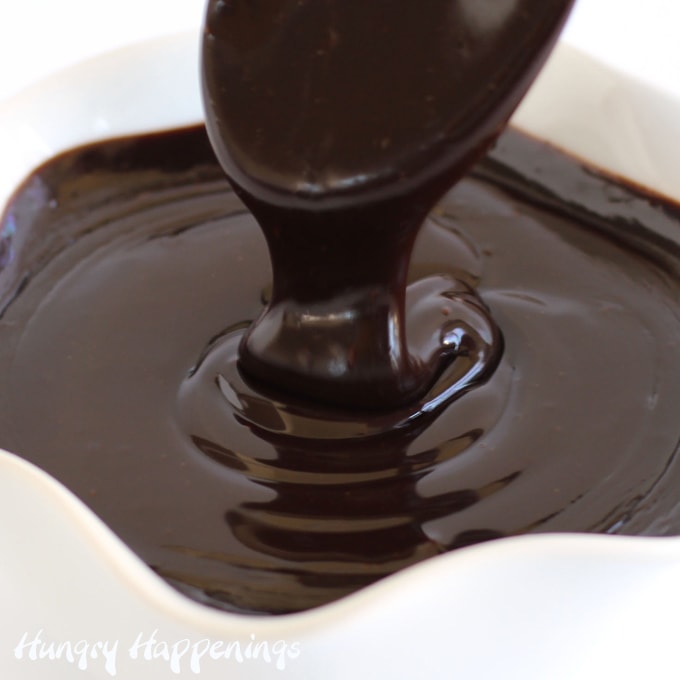
Learn how to melt chocolate.
First, you need to get your chocolate into small uniform-size pieces.
How to chop chocolate?
- If you are using a large block of chocolate or a candy bar, chop your chocolate into small uniform pieces. The best way to do this is to use a serrated knife to shave off small bits of chocolate.
- Place the knife blade on the edge of the chocolate block, and press down on the top of the knife while shaving off a small amount of chocolate. Then just chop any larger bits before using.
- You can also use a food processor to chop your chocolate. Add small chunks of chocolate to the bowl of the food processor and pulse until you have fine crumbs
- You can also grate the chocolate using a grating wheel in your food processor.
Melting chocolate in a double boiler.

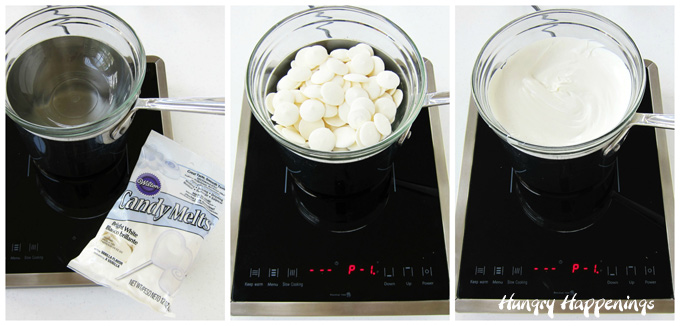
- Heat 1” of water over low heat in a saucepan.
- Place a bowl over the saucepan, being sure the bottom doesn't touch the water.
- Put chopped chocolate, wafers, or chips in the bowl and stir occasionally until melted.
- This process is slow. Do not raise the temperature to speed things up. If you do, you can burn your chocolate.
It is very important that you do not allow any water to come in contact with the chocolate. Chocolate mixed with a drop or a few drops of water will seize (stiffen or harden).
If this happens your only option is to add more liquid in order to get the chocolate smooth again. However, you can not use this thinned batch of chocolate for tempering or dipping as it will never harden properly.
All is not lost as you can turn it into a delicious chocolate ganache or use it for baking.
Melting chocolate in the microwave.
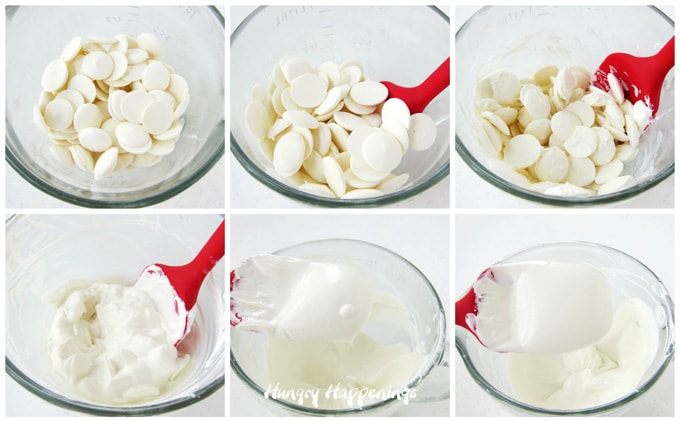
Every microwave is different so this is just a guideline, but it is safest to go slow and stir often. I always use high power for short bursts of time.
The amount of time needed to melt your chocolate will depend on how much chocolate you need to melt. The instructions below are based on 16 ounces of chocolate or confectionery coating wafers.
- Pour finely chopped chocolate, Candy Melt wafers, chocolate callets, or chocolate chips into a microwave-safe bowl.
- Heat on high power for 30 seconds, remove from microwave and stir. Your chocolate won't look melted much at all at this point, but if you don't stir it, you may burn the chocolate in the center of the bowl.
- Return to the microwave and heat for 30 seconds. At this point, the chocolate will look only slightly melted around the edges.
- Continue to stir and the chunks will indeed start to become liquid.
- Continue to heat for 30 seconds. Now your chocolate will look more liquid, but you will have chunks remaining.
- Allow the chocolate to sit for 1-2 minutes, preferably in the microwave, then stir vigorously and the heat from the melted chocolate will melt the chunks.
- If, after stirring for a while you still have chunks of chocolate remaining, heat for 10-15 second intervals, stirring in between each until melted.
- Do not rush this process. Chocolate burns easily. If you do burn the chocolate, throw it away and start over in a clean bowl. To melt more than 16 ounces, you can increase your times by 10-15 seconds per interval. For 2 lbs. (45 seconds, 35, 25, 10). For 3 lbs. (60 seconds, 45, 30, 20). If your microwave is less powerful, increase the times, but go slowly.
Melting candy melts in a melting pot.
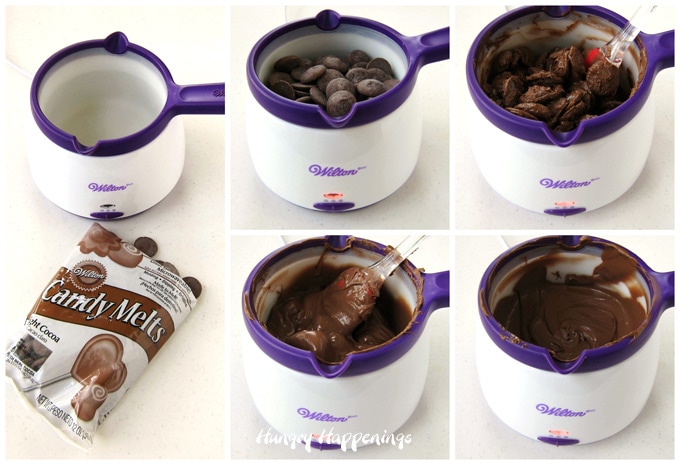
- Fill the silicone bowl in a Wilton Melting Pot with candy melts.
- Turn on low heat.
- Stir often, until the chocolate melts.
- If you use the high heat setting to melt the chocolate, be sure to stir it more frequently, then turn it down to low once the chocolate is melted.
- You can keep compound chocolate (candy melts) melted for hours using a melter.
Melting candy melts using an electric skillet.
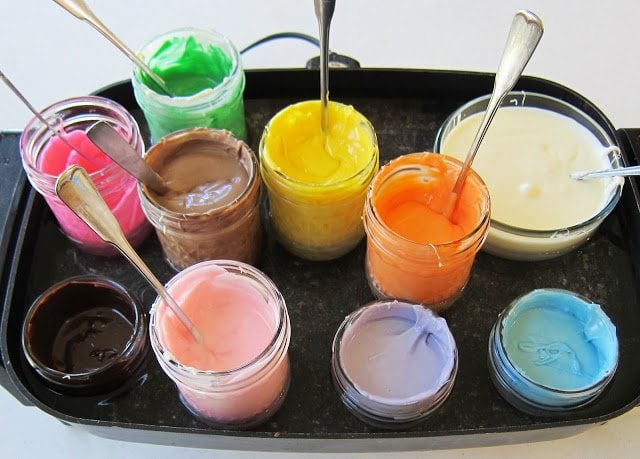
- Fill glass jars or coffee mugs with candy melts wafers.
- Set the jars into an electric skillet.
- Fill the skillet with an inch or two of hot water.
- Turn the skillet to the lowest setting. My skillet has a warm setting which works great.
- Allow the water to warm up and the candy melts to melt, stirring often.
- You can also melt the candy melts using the microwave then place the jars in the water bath in the skillet to keep them melted all day. Be sure to replenish the water as it evaporates.
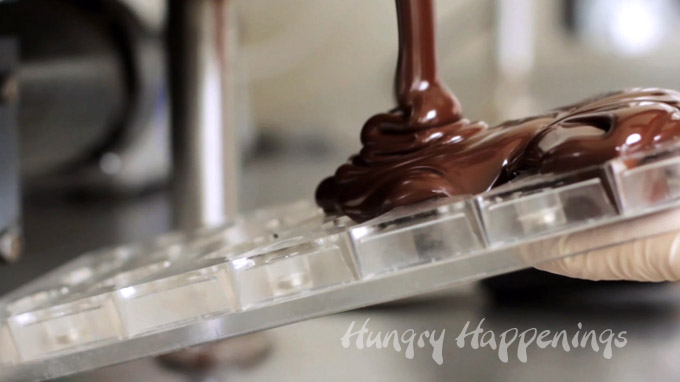
How to Temper Pure Chocolate?
Pure chocolate contains cocoa butter and when melted, the crystals in the cocoa butter lose their structure. In order to get that crystal structure back in alignment, you have to heat and cool the chocolate properly, so that the chocolate sets up properly.
Any chocolate that you purchase from the store that contains cocoa butter is already in temper but once you melt it, it can go out of temper if it gets too hot.
What does tempering mean?
Tempering refers to a process of heating and cooling pure chocolate to ensure that the cocoa butter in the chocolate hardens in a uniform crystal structure. When you buy pure chocolate, it is in temper. When you melt the chocolate to reuse it, you take it out of temper and need to bring it back.
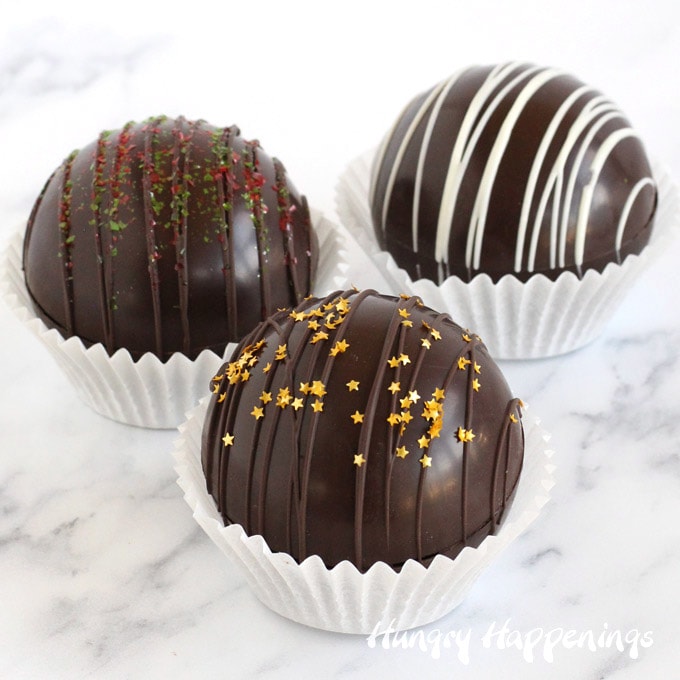
Chocolate that is tempered has:
- a smooth texture
- a glossy shine (like the hot chocolate bombs pictured above)
- snaps when broken
Chocolate that is not tempered correctly might be:
- cloudy
- gray
- sticky
- soft
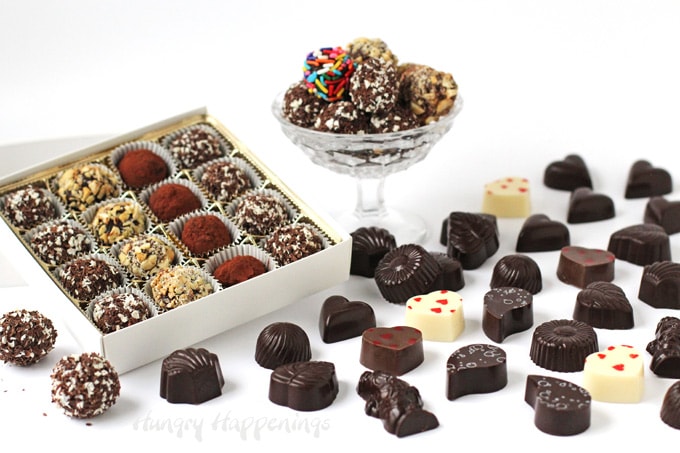
Learn to make these gorgeous truffles in my Chocolate Making Course
Easy Microwave Chocolate Tempering
If you are very careful, you can melt pure chocolate without taking it out of temper.
- Finely chop or grate your chocolate and place it in a microwave-safe bowl.
- Heat on high for 15 seconds, then remove the bowl and stir. Note: if using more than 12 ounces, you can start by heating it for 30 seconds.
- Then heat on high for 10 to 15-second increments, stirring after each, until melted. As you get close to melting, cut the heat to 50% power or the time to 5 seconds.
- When using this tempering method you want to be very careful not to get your chocolate too hot. You want the melted chocolate to be between:
- 88° F - 91° F (31° C - 32° C) for Dark Chocolate
- 86° F - 88° (30° C - 31° C) for Milk Chocolate
- 84° F - 86° (29° C - 30° C) for White Chocolate
- If the temperature of your chocolate goes above these numbers and you still have pieces of chocolate remaining in the bowl, continue to stir and allow that chocolate to melt. Check the temperature once all of the chocolate melts. If it is within the ranges listed above, your chocolate should be in temper.
- If the temperature of the melted chocolate is above the range, then you must use another method to temper the chocolate. I recommend the seeding method listed below.
Seeding Method of Tempering Chocolate
- Chop your chocolate into really fine pieces.
- Divide the chocolate and reserve 25% (¼) of it to seed the melted chocolate.
- Heat 74% (¾) of the chopped chocolate in the microwave on high power for 15 to 30-second increments, stirring after each.
- The heat in the bowl of melted chocolate will continue to help melt the solid pieces so as you get close to having all your chocolate melted, allow the chocolate to rest in the bowl for a minute before stirring.
- Heat until the chocolate melts and reaches:
- 115°-120° F (46°-49° degrees C) for dark chocolate
- 110°-115° degrees F (43°-46° C) for milk chocolate
- 110° F (43° C) for white chocolate
- Add about half of the reserved chocolate to the melted chocolate and stir until melted.
- Check the temperature of the chocolate. The goal is the get the chocolate to:
- 88° F - 90° F (31° C - 32° C) for Dark Chocolate
- 86° F - 88° (30° C - 31° C) for Milk Chocolate
- 84° F - 86° (29° C - 30° C) for White Chocolate
- Note that these temperatures can vary depending on the brand of chocolate.
- Continue to add a small amount of the remaining chocolate into the melted chocolate and stir until either all of the chocolate melts or your chocolate reaches the desired temperature.
- It’s best to stop at the upper end of the temperature range because the chocolate will continue to cool slightly as you are checking the temper.
- To check the temper, dip the end of a metal spatula or knife into the chocolate and allow all the excess chocolate to drip off. You want a really thin coating of chocolate on the spatula. If the chocolate dries hard and looks shiny, within 3-5 minutes, then the chocolate is in temper.
VIDEO
Watch the video to see how to temper chocolate using the seeding method.
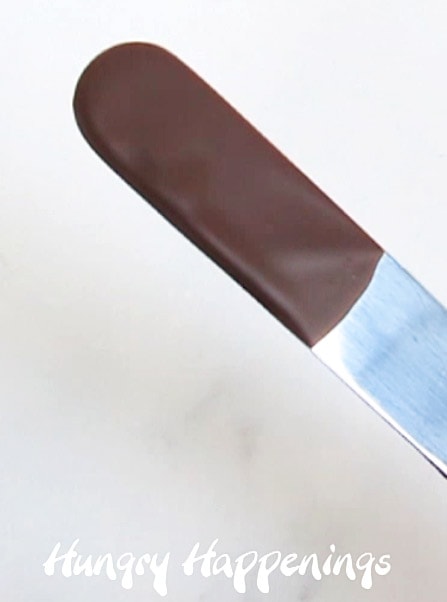
How to know if chocolate is in temper?
- Test the temper of the chocolate by dipping a metal spatula, spoon, or knife into the chocolate.
- Shake it, to remove the excess chocolate then set it aside at room temperature.
- In 3-5 minutes, the chocolate should harden and look shiny.
- Alternatively, you can spread a small amount of chocolate on a piece of parchment paper and allow it to air dry for 3-5 minutes. It should peel off the paper and snap when broken.
- While you are waiting, be sure to stir your bowl of chocolate, to make sure it doesn't cool too much around the edge.
- If your test chocolate has hardened and looks shiny be sure to check the temperature of your bowl of chocolate before proceeding to make your chocolate balls.
- The chocolate will have cooled slightly and will need to be warmed slightly!
- Heat it in the microwave for about 5 seconds then remove and stir and check the temperature. Do not let it go above temper temperature (88° milk or 84° white). If it does, you have to start this whole process over again.
- You are now ready to fill your molds with chocolate.
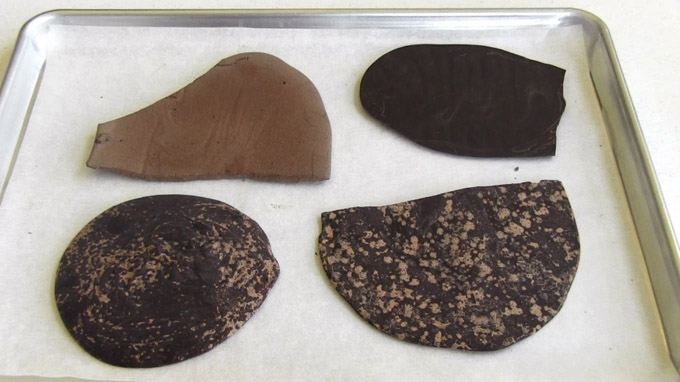
Can I skip tempering pure chocolate?
- NO. Do not skip tempering pure chocolate!
- Chocolate that is not tempered properly will be soft, streaky, spotty, or even chalky. The chocolate that is pictured above is all out of temper.
- Chocolate that is not properly tempered will not harden and retract from a mold.
How to keep chocolate in temper?
- To keep the chocolate in temper, you can heat the chocolate in the microwave for 3-5 seconds which is just long enough to warm it slightly.
- Or you can use a hot blow dryer, to heat up the bowl of chocolate, by blowing the hot air on the outside of the bowl.
- Keep an eye on the temperature of the chocolate. You don't want it to go above the temperatures listed above. If it does, then you'll need to start the tempering process again by raising the temperature to 115° F (46° C), seeing it with more tempered chocolate, and lowering the temperature to those listed above.
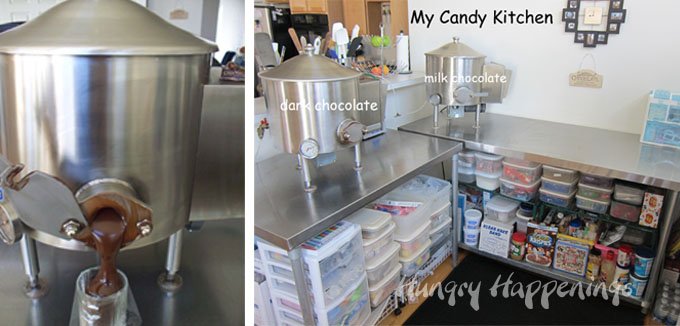
Chocolate Tempering Machines
If you are serious about making a lot of chocolate, you might want to consider buying some chocolate tempering machines.
I own two Savage Brothers melters and love them. I don't have to hand temper my chocolates. The machines do the work for me. It's great. I leave melted chocolate in my machines 365 days a year. I temper it as needed.
Each of my machines holds 50 pounds of chocolate, which is the smallest Savage Bros. makes, but other companies make smaller tabletop tempering machines. You can even get a machine that will temper just one or two pounds of chocolate at a time.
 ChocoVision Revolation Delt...Shop on Amazon
ChocoVision Revolation Delt...Shop on Amazon  ChocoVision Revolation 2 Ch...Shop on Amazon
ChocoVision Revolation 2 Ch...Shop on Amazon  HILLIARD'S Chocolate Temper...Shop on Amazon
HILLIARD'S Chocolate Temper...Shop on Amazon  ChocoVision Mini Rev Chocol...Shop on Amazon
ChocoVision Mini Rev Chocol...Shop on AmazonI prefer to use pure (real) chocolate to make my confections because the flavor is far superior to any other chocolate product.
I have made some really fun holiday treats using pure chocolate and shared the recipes and tutorials here on Hungry Happenings.

Using pure chocolate, you can make:
Buckeye Bears • Chocolate Cauldrons • Chocolate Heart Boxes • Chocolate Pilgrim Hats • Chocolate Penguin Truffles

Using Confectionery Coating, you can make lollipops, cake pops, filled candies, dipped cookies, Rice Krispie treats, and more including:
Chocolate Bunny Silhouettes, Candy Filled Chicks, Cake Ball Brains, Snowman Rice Krispies Treats, Animal Print Mickey Pops
If you prefer learning via video then be sure to check out my
Chocolate Making Courses at The Sugar Academy
Save 20% off using coupon code HUNGRYBLOG20
The videos feature 3 ½ hours of instructions and are broken down into 3 separate courses or one full-length bundle.
Can I use chocolate chips to make homemade chocolate?
Yes, but you need to know how to use them properly.
- Chocolate Chips can be pure chocolate or compound chocolate. You need to look at the ingredients to determine the type of chocolate.
- Pure chocolate chips will have cocoa butter listed in the ingredients and will need to be tempered.
- Most dark and milk chocolate chips are pure chocolate, but many white chocolate chips, like Nestle Premier White Morsels, are not, they are compound chocolates.
Chocolate Chips are:
- made to keep their shape in high heat
- melt very slowly
- have to be tempered if they contain cocoa butter
- come in semi-sweet, bittersweet, milk, white, peanut butter, butterscotch, and more flavors
- can be used as decoration on edible crafts
Should I add wax to chocolate chips when making homemade chocolate?
NO!
It is common practice in old candy-making recipes to add paraffin (wax) to melted chocolate chips so that the chocolate will set up properly. I don't advise this, as it adds a terrible mouthfeel and taste to the finished chocolates. Plus, who wants to eat wax? Not me.
If you use chocolate chips to make candies, you have to temper the chocolate in order for it to set properly. If you don't want to go through that much effort, then you are better off using confectionery coatings to make your candies.

You can use variations of chocolate chips and peanut butter chips to make sweet treats including:
Peanut Butter Starfish, Mini Pumpkin Cheesecake, Polar Bear Ice Cream Cones, Chocolate Chip Cookie Serving Bowl, Happy Chocolate Chip Cookies
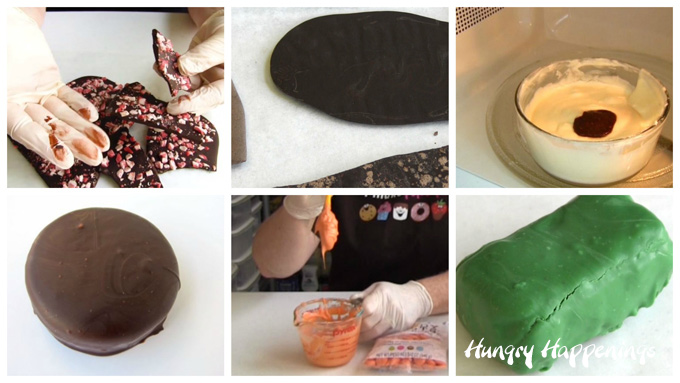
Troubleshooting Tips
When making homemade chocolate things can go wrong. Let's talk about how to fix the problems.
my chocolate is too soft and it melts too easily
- If your chocolate is too soft, like the peppermint bark shown above, it is not in temper. You must temper pure chocolate so that it hardens properly and has a good snap when broken.
- See the tempering instructions above.
my chocolate pieces have white spots or streaks
- Chocolate that has not been tempered properly or that has not been stored properly will develop white streaks and spots (fat bloom or sugar bloom). These spots are actually cocoa butter crystals that have separated from the cocoa solids.
- White spots and streaks in untempered chocolate may appear hours or days after your chocolate sets.
- See the tempering instructions above.
my chocolate is burnt
- If you overheat your chocolate in the microwave or on the stove it will burn.
- You cannot salvage burnt chocolate. It is ruined.
- Even if only a small portion of the chocolate looks like, like in the image above, the entire bowl of chocolate will taste burnt. Throw it all away, and start over.
- That's why I suggest using short bursts of power, stirring after each, when melting chocolate or candy melts in the microwave.
my chocolate is sticky and wet
- Chocolates that have been stored in the freezer or refrigerator will develop condensation (beads of water).
- To ensure your chocolate candies do not become sticky, store them at room temperature.
- If you do refrigerate or freeze your chocolate candies, wrap them well in plastic wrap, wax paper, or tin foil, then place them in a zip-top bag or airtight container. Thaw at room temperature in the packaging for several hours before unwrapping.
- If you are making homemade chocolates and they are left in the freezer or refrigerator for too long, they can become sticky too. So, be sure to remove your chocolate as soon as it hardens.
my melted candy melts are too thick
Compound chocolates (candy melts) can become thick for several reasons:
- they are heated to too high a temperature
- they have been stored improperly (in moist damp areas, in direct sunlight, near a heat vent, in the refrigerator or freezer)
- they are old (the older they get, the thicker they get)
- they have gone through drastic temperature changes (from hot to cold or cold to hot)
- they are exposed to moisture (even one drop of water or condensation can thicken your candy melts or chocolate)
To thin out thick candy melts:
- If once melted, your confectionery coating is really thick, add Paramount Crystals or Wilton Easy Thin which are flakes of palm kernel oil, to thin out the coating.
- Simply add a small pinch of the flakes and stir. If the candy melts are not thin enough, then add another small amount of the crystals and stir.
- You can use Crisco or vegetable oil instead, but your candy coating may be a bit soft once hardened.
You can thin pure chocolate or chocolate chips by adding some cocoa butter.
 Wilton EZ Thin Dipping Aid ...Shop on Amazon
Wilton EZ Thin Dipping Aid ...Shop on Amazon  CK Products Paramount Cryst...Shop on Amazon
CK Products Paramount Cryst...Shop on Amazon  Raw Cocoa Butter-16 oz. - N...Shop on Amazon
Raw Cocoa Butter-16 oz. - N...Shop on Amazon my chocolate is cracked
- Chocolate will crack when it's too cold.
- If you dip something into the chocolate and it's cold, the chocolate coating can crack. So be sure anything you dip in chocolate, like cake balls, or chocolate truffles, is at room temperature.
- If you are chilling compound chocolates (candy melts) in the freezer, be sure to remove the candy as soon as it has hardened. If candies are frozen for too long, they will crack.
BE SURE TO CHECK OUT THESE OTHER CHOCOLATE-MAKING TIPS TUTORIALS.
- How to Color White Chocolate or Confectionery Coating
- How to Use Colored White Chocolate to Paint Candy Molds to make Lollipops and more
- How to make Modeling Chocolate (chocolate clay) - Modeling Chocolate Recipe
- How to fix greasy, oily, dry, crumbly, or soft modeling chocolate (candy clay)
- How to roll out modeling chocolate
- How to Cut Modeling chocolate
- How to make Hot Chocolate Bombs
- How to make Chocolate Truffles
Learn more at The Sugar Academy
Save 20% off the chocolate making courses at The Sugar Academy using coupon code HUNGRYBLOG20
Now that you know the chocolate making basics you are ready to learn more.
Candy Clay Creations
If you want to learn all about making modeling chocolate (candy clay) be sure to also check out my book, Candy Clay Creations.
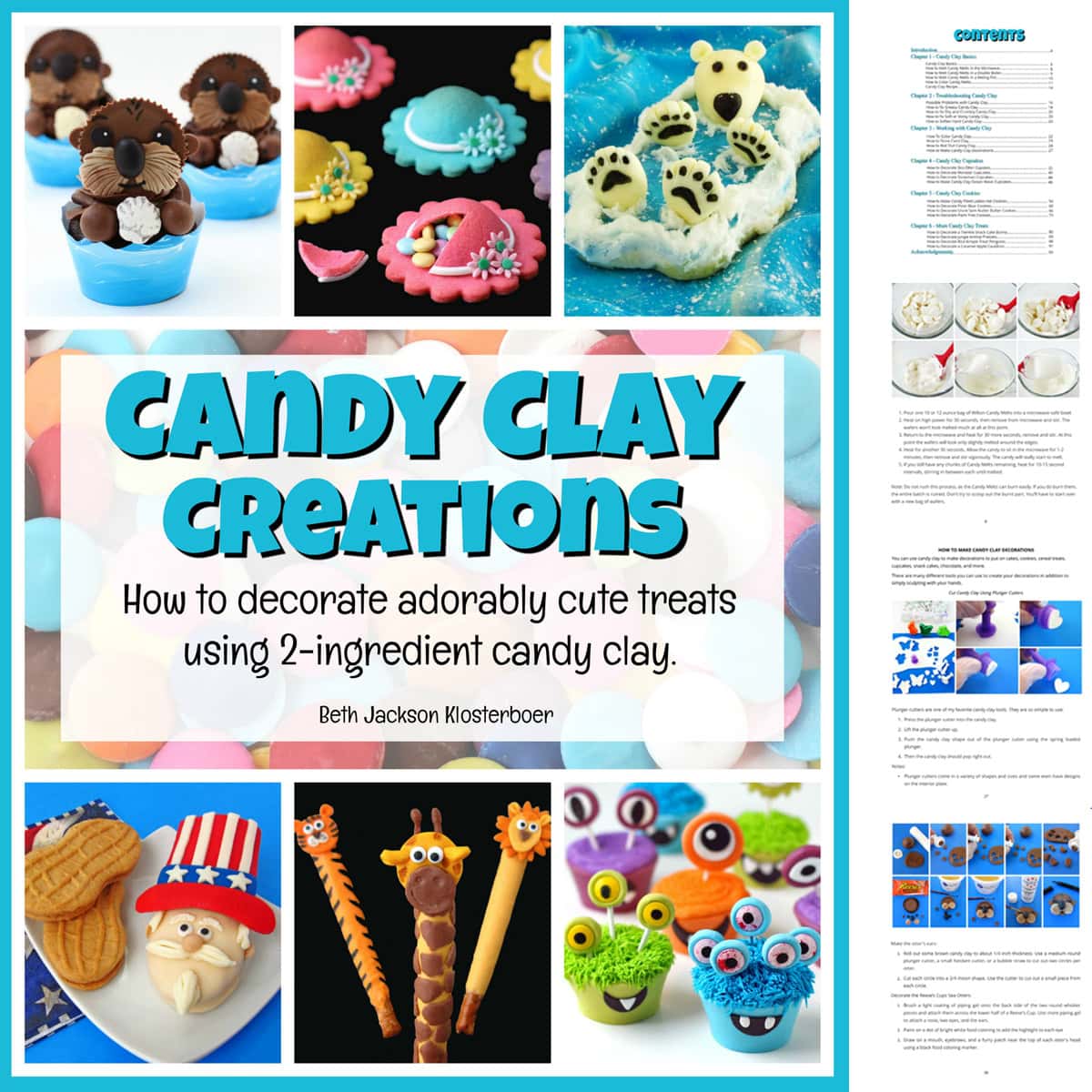
- Irresistible Sweets with Dixie Crystals® - July 13, 2024
- How to make peanut butter? - February 15, 2024
- OREO Penguins - December 20, 2023


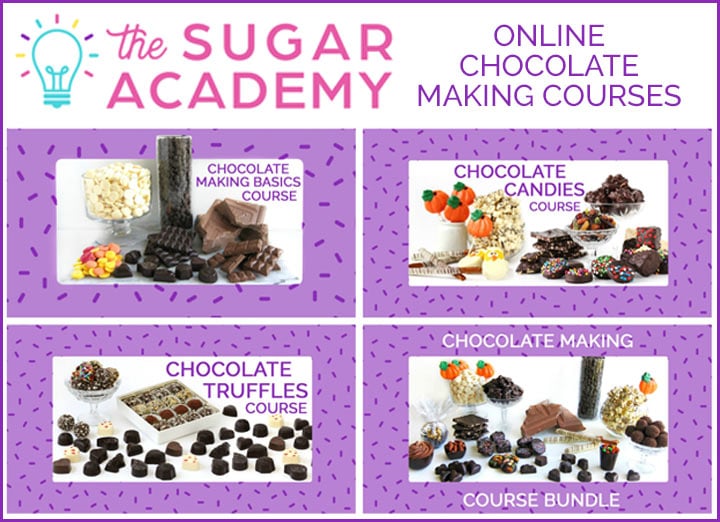
Patty says
Hi Beth,
You have such great ideas and instructions. I can't wait to try them all. I have been making chocolates for many years using Merkens wafers and molds. I've bought the pre-made fondant and didn't like the taste, so I can't wait to make some using your instructions. I do have a suggestion, when I needed to have small amounts of different colors to "paint" the molds, I tried many times to use the hot water bath and many times I get water in the chocolate. I have since found a couple of different ways to keep the chocolate melted. I've used a heating pad but then I found an electric griddle that has a thermostat so you can set it on a really low temperature so it just stays warm. This has worked for me the best, no water to drip in my chocolate. I have even set the plastic bottles on it and it didn't melt the bottle, but kept the chocolate melted. I still use the microwave to initially melt the chocolate, but then use the warmer to keep it melted.
Have you ever tried this?
Anonymous says
Hi Could you direct me to a site that sells the bunny sucker with the bow tie?
beth says
Sorry to say the company that made that mold went out of business last year, so it's no longer available.
Anonymous says
Can you recommend me a plastic brush like yours, preferably from amazon?
beth says
Yay! I actually found the same paint brushes that I use. Here is the link on Amazon.com:
http://www.amazon.com/gp/product/B0006N6OGU/ref=as_li_tf_tl?ie=UTF8&camp=1789&creative=9325&creativeASIN=B0006N6OGU&linkCode=as2&tag=hungryh-20
Andriani Prokopiou says
Hello, thank you for your instant reply, I found the following but are not plastic, ( I bough the second one) Now, I will buy this that you propose me 🙂
http://www.amazon.com/gp/product/B0050B1HR4/ref=gno_cart_title_2?ie=UTF8&psc=1&smid=A1GXT7IMS99GT
http://www.amazon.com/gp/product/B00076TPKI/ref=oh_details_o02_s00_i00?ie=UTF8&psc=1
Sent from my iPad
Andriani Prokopiou says
Hello, I am looking for the plastic brushes that you use, can you recommend me one, preferably from amazon?
Anonymous says
Hi Beth!
Thanks for all the excellent information. I did try looking through all the comments to see if someone also posted this so forgive me if you've already responded to this question.
I would like to try using those chocolate transfer sheets or the textured sheets for chocolate but its seems like there are so many different versions out there (and so many different prices as well). Could you recommend good kinds and also good places to purchase online? Thanks so much!
beth says
I love working with transfer sheets. I buy mine from a wholesale company, but there are quite a few places you can buy them on-line. Here's links to two of them - http://www.chocotransfersheets.com/shop/category.aspx?catid=27
http://www.countrykitchensa.com/shop/food-items/chocolate-transfer-sheets/46/624/1544/
redneckpenguin says
Hi, I have just started making things from fondant for my cakes. I've done well with flowers and toys, but realistic faces and animals do not turn out as well. I've practiced with regular clay and like how you can blend it together to make seamless joints and add features and muscles. Can modeling chocolate be used the same way? Would it work better on it's own for this or mixed with fondant or gumpaste? Thank you for sharing your expertise. Lynn
beth says
Modeling chocolate can be used the same way as clay. I've never mixed it with fondant or gumpaste. I like it just the way it is, and don't see the necessity to mix it. I like that modeling chocolate is easy to sculpt but hardens and holds it's shape really well, plus it tastes great.
Natalie Hoffman says
Hello Beth! I'm trying to buy a candy and deep fry thermometer but I'm not sure which one to buy. Is there any brand you recommend? 🙂
beth says
Hi Natalie,
I have used both Wilton and Taylor candy thermometers and both are good. The very best thermometer I have is by Thermapen. It is very pricey, but I love it.
Melissa Miller says
Wow! I'm impressed and excited! Can you use anything besides corn syrup to make modeling chocolate? I'm looking for something 100% natural or organic. Stopping by from Tell Me About It Tuesday!
beth says
HI Melissa,
I have successfully used honey (https://hungryhappenings.com/2011/05/how-to-create-school-books-using-corn.html,) jelly (https://hungryhappenings.com/2013/05/strawberry-basket-gifts-for-mom-teachers-friends.html,) dulce de leche (https://hungryhappenings.com/2011/06/celebrate-end-of-school-year-by-making.html,) and even peanut butter (https://hungryhappenings.com/2012/11/chocolate-peanut-butter-fudge-or.html) to make modeling chocolate. Take a look at these posts to see how I did it.
Lils says
Hi, this is very interesting. I want to try making a modeling chocolate. My question is, can I Substitute the corn syrup with e.g. maple syrup? I live in Germany and haven't seen corn syrup on the shelf! What other substitute may I use??
beth says
I have successfully used honey (https://hungryhappenings.com/2011/05/how-to-create-school-books-using-corn.html,) jelly (https://hungryhappenings.com/2013/05/strawberry-basket-gifts-for-mom-teachers-friends.html,) dulce de leche (https://hungryhappenings.com/2011/06/celebrate-end-of-school-year-by-making.html,) and even peanut butter (https://hungryhappenings.com/2012/11/chocolate-peanut-butter-fudge-or.html) to make modeling chocolate. Take a look at these posts to see how I did it.
Anonymous says
trying to substitute unsweetened cocoa/sugar & oil for semi sweet chips for a light frosting. The sugar is making the chocolate too grainy ...any solutions?
beth says
It's hard to dissolve granulated sugar in a frosting. You could try using powdered sugar instead.
Unknown says
Many thanks Beth for the detailed explanation. You are awesome.
Jane says
This tutorial was a lifesaver-I was making a damask wallpaper cake this weekend, and I used your tutorial to sculpt all of the individual components! Thanks so much 🙂
beth says
Hi Jane, I'm so happy you found my tips helpful. I hope your cake turns out great!
Victoria E. says
Hi, I need to know the temperature of the white chocolate when I put the color in it. Thanks for your help.
beth says
If you are using pure white chocolate (made with cocoa butter) the chocolate should be between 88-90 degrees Fahrenheit. If you are using white chocolate coating (made with hydrogenated oil or palm kernal oil) it should be between 100-110 degrees fahrenheit.
Victoria E. says
HI, I need to know what should be the temperature of white chocolate when put the color in it, because looks like the color not mix very well when the chocolate is hot. Thanks for your help.
Victoria E. says
Hi, I need to know the temperature of the white chocolate when I put the color in it. Thanks for your help.
Vrinda Kini says
Hi, Thankyou for the awesome post. I tried making molding chocolate by using 50 gms white chocolate compound and 1 tbsp light corn syrup. Morde's Chocolate compound available in India contains sugar, milk solids hydrogenated vegetable oil and antioxidant I wanted to try making flowers to decorate my cake (I dislike fondant). I now understand why so much fat got released (excellent skin softner btw!!) . I used the chocolate dough anyway, since it was still very pliable. The flowers came out beautiful, but some how did not harden and became a little soft when I placed them on a cake covered with whipped cream. I was searching the net for " how to make chocolate molding flowers stiff when I came across your excellent post. How do I get the flowers to become stiff. Pl help, I would like to make cake decorations with chocolate instead of fondant.
beth says
First, I would make a flower and let it sit for at least a few hours to dry before putting it on the cake. All modeling chocolate will soften a bit once added to a frosted cake. If you give the flowers plenty of time to really dry, it will take much longer for them to soften once on the cake.
If your modeling chocolate is just too soft and wont dry hard, you can do one of two things. The easiest is to just knead in some powdered sugar (confectioners sugar) to help dry things out a bit. Then make your flowers and allow them to dry before putting on your cake. Another method would be to knead in some melted chocolate. If you do this you need to make sure the chocolate is just barely warm (88-90 degrees Fahrenheit) before kneading it in to the modeling chocolate. You probably don't need much, to give your modeling chocolate more structure. I've had success doing this, but it can be tricky.
I hope this helps.
Anonymous says
CAN U SUGGEST DT MORDE BRAND CHOCOLATE COMPOUNDS CAN B USED INSTEAD F D MODELLING CLAY?
beth says
I'm sorry, I'm not familiar with DT Morde Brand Chocolate. You can use any brand or type of chocolate to make modeling chocolate/chocolate clay. You can not use regular chocolate in place of modeling chocolate/chocolate clay. Chocolate clay is flexible like fondant and can be sculpted like clay. I hope that answers your question.
Anonymous says
thanks for you wonderful site, made the white modeling chocolate today, almost gave up, it was very very crumbly, until I found your site, then just added way more corn syrup, voila, it worked am soooooo excited, and can't wait to get to work on my nieces Dolly Varden cake. THANK YOU soooo much 🙂
beth says
I'm so glad you didn't give up and that you found my advice helpful. Once you figure out the formula to make modeling chocolate using the brand of white chocolate you are using, it will go so much smoother. I love working with it and just finished making several new recipe posts featuring modeling chocolate.
Anonymous says
Hi! I am new for chocolate . What is the different between compound and converture chocolate? Can i use compound chocolate for modeling?
beth says
Compound coating is made with hydrogenated oils like palm kernal oil, while coverture is made using cocoa butter. I use both to make modeling chocolate. I almost always use white coating to make it, and always use pure milk and semi-sweet chocolates. As I mention above, the amount of corn syrup you'll need with depend on the type and brand of chocolate you use. You just have to play with the amounts until you find what works for the chocolate or coating you are using.
Anonymous says
Just joining in with everyone to thank you for such amazing information.
Question - would you think chocolate chips are considered "chocolate" or would you only use chunks of "real" chocolate?
beth says
Any chocolate, including chips, that are made with cocoa butter, and not vegetable oils like palm kernal oil, are considered to be pure or real chocolate. Just note, that chocolate chips are formulated to stay in a chip shape even at high temperatures. You can melt them, but they don't melt as easily as a chocolate bar. You also need to temper the chocolate chips if you melt them and want it to set properly and have a nice shine.